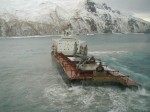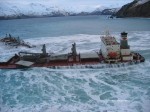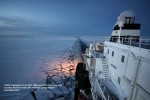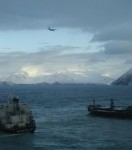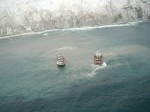http://www.oceanfdn.org/blog/?p=1303
Posted on December 8, 2012
By Richard Steiner
When the Malaysian freighter Selendang Ayu grounded in Alaska’s Aleutian Islands eight years ago this week, it was a tragic reminder of the growing risks of northern shipping. While in-route from Seattle to China, in a fierce Bering Sea winter storm with 70-knot winds and 25-foot seas, the ship’s engine failed. As it drifted toward shore, there were no adequate ocean tugs available to take it in-tow, and it grounded off Unalaska Island on December 8, 2004. Six crewmen were lost, the vessel broke in half, and its entire cargo and over 335,000 gallons of heavy fuel spilled oil into waters of the Alaska Maritime National Wildlife Refuge (Alaska Maritime National Wildlife Refuge). Like other large marine spills, this spill was not contained, and it killed thousands of seabirds and other marine wildlife, closed fisheries, and contaminated many miles of shoreline.
Like most industrial disasters, the Selendang Ayu tragedy was caused by a dangerous combination of human error, financial pressures, mechanical failure, lax and government oversight, ([PDF]Grounding of Malaysian-flag Bulk Carrier M/V Selendang Ayu on). For a time, the disaster focused attention the risk of northern shipping. But while some risk factors were addressed, complacency quickly returned. Today, the Selendang tragedy is all but forgotten, and with increasing ship traffic, the risk now is greater than ever.
Every day, some 10-20 large merchant ships – container ships, bulk carriers, car carriers, and tankers – travel the “great circle route” between Asia and North America along the 1,200-mile Aleutian chain. As trade rebounds from the recession, shipping along this route is steadily increasing. And as global warming continues to melt summer sea ice, ship traffic is also rapidly increasing across the Arctic Ocean. This past summer, a record 46 merchant ships transited the Northern Sea Route between Europe and Asia across the Russian arctic (Barents Observer), a ten-fold increase from just two years ago. Over 1 million tons of cargo was hauled on the route in both directions this summer (a 50% increase over 2011), and most of this was hazardous petroleum product such as diesel fuel, jet fuel, and gas condensate. And the first Liquefied Natural Gas (LNG) tanker in history traveled the route this year, carrying LNG from Norway to Japan in half the time it would have taken to travel the normal Suez route. The volume of oil and gas shipped on the Northern Sea Route is projected to reach 40 million tons annually by 2020. There is also increasing traffic of cruise ships (particularly around Greenland), fishing vessels, and ships servicing arctic oil and gas facilities and mines.
This is risky business. These are large vessels, carrying hazardous fuel and cargo, sailing treacherous seas along ecologically sensitive shorelines, operated by companies whose commercial imperatives often subvert safety, and with virtually no prevention or emergency response infrastructure along the way. Much of this traffic is foreign flagged and on “innocent passage,” under a Flag-of-Convenience
(What are Flags of Convenience?), with a Crew-of-Convenience, and with lower safety standards. And it all happens virtually out-of-sight, out-of-mind of the public and government regulators. Each of these ship transits puts at risk human life, economy, and environment, and the risk is growing every year. Shipping brings with it invasive species introductions, underwater noise, ship-strikes on marine mammals, and stack emissions. But as some of these vessels carry millions of gallons of heavy fuel, and tankers carry tens of millions of gallons of petroleum or chemicals, clearly the greatest fear is a catastrophic spill.
In response to the Selendang disaster, a coalition of non-governmental organizations, Alaska Natives, and commercial fishermen joined together in the Shipping Safety Partnership to advocate comprehensive safety improvements along the Aleutian and Arctic shipping routes (Alaska Oil Spill Motivates New Shipping Safety Coalition). In 2005, the Partnership called for real-time tracking of all ships, ocean rescue tugs, emergency tow packages, routing agreements, areas-to-be-avoided, increased financial liability, better aids-to-navigation, enhanced pilotage, mandatory communication protocols, better spill response equipment, increased cargo fees, and vessel traffic risk assessments. A few of these (the “low-hanging fruit”) have been implemented: additional tracking stations have been built, portable tow packages are pre-staged in Dutch Harbor, there is more funding and spill response equipment, an Arctic Marine Shipping Assessment was conducted (PUBLICATIONS > Related > AMSA – U.S. Arctic Research …), and an Aleutian shipping risk assessment is underway (Aleutian Islands Risk Assessment Project Home Page).
But in reducing the overall risk of Arctic and Aleutian shipping, the glass is still perhaps one-quarter full, three-quarters empty. The system is far from secure. For instance, ship-tracking remains inadequate, and still there are no powerful ocean rescue tugs stationed along the routes. By comparison, after Exxon Valdez, Prince William Sound now has eleven escort & response tugs on standby for its tankers (Alyeska Pipeline – TAPS – SERVS). In the Aleutians, a 2009 National Academy of Sciences report concluded: “None of the existing measures are adequate for responding to large vessels under severe weather conditions.”
Two areas of greatest concern, through which most of these ships travel, are Unimak Pass (between the Gulf of Alaska and Bering Sea in the eastern Aleutians), and Bering Strait (between the Bering Sea and Arctic Ocean). As these areas support more marine mammals, seabirds, fish, crab, and overall productivity than virtually any other ocean ecosystem in the world, the risk is clear. One wrong turn or loss of power of a loaded tanker or freighter in these passes could easily lead to a major spill disaster. Accordingly, both Unimak Pass and Bering Strait were recommended in 2009 for international designation as Particularly Sensitive Sea Areas, and Marine National Monuments or Sanctuaries, but the U.S. government has yet to act on this recommendation (Don’t Expect New Marine Sanctuaries Under … – Common Dreams).
Clearly, we need to get a handle on this now, before the next disaster. All of the Shipping Safety Partnership’s recommendations from 2005 (above) should immediately be implemented across the Aleutian and Arctic shipping routes, particularly continuous ship tracking and rescue tugs. Industry should pay for it all via cargo fees. And, governments should make mandatory the International Maritime Organization’s Guidelines for Ships Operating in Arctic ice-covered Waters (IMO | Polar Shipping Safety), enhance search and rescue capacity, and establish Regional Citizens’ Advisory Councils (Prince William Sound Regional Citizens’ Advisory Council) to oversee all offshore commercial activities.
Arctic shipping is a disaster waiting to happen. It’s not if, but when and where the next disaster will occur. It could be tonight or years from now; it could be in Unimak Pass, Bering Strait, Novaya Zemlya, Baffin Island, or Greenland. But it will happen. Arctic governments and the shipping industry need to get serious about reducing this risk as much as possible, and soon.
Richard Steiner conducts the Oasis Earth project – a global consultancy working with NGOs, governments, industry, and civil society to speed the transition to an environmentally sustainable society. Oasis Earth conducts Rapid Assessments for NGOs in developing nations on critical conservation challenges, reviews environmental assessments, and conducts fully developed studies.
Special thanks to Mark Spalding and The Ocean Foundation.
